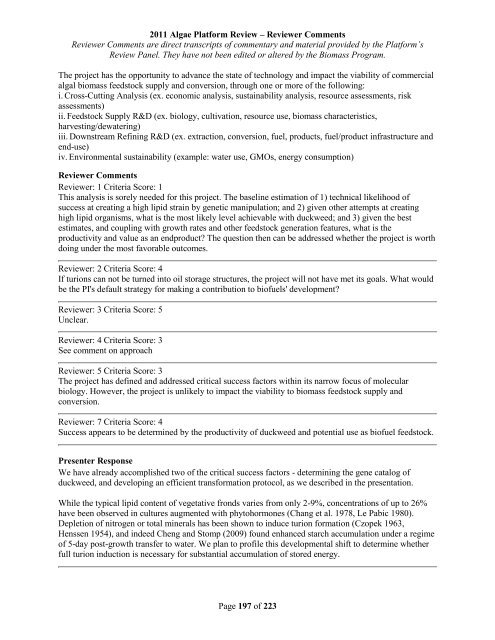Reviewer Comments - EERE
Reviewer Comments - EERE
Reviewer Comments - EERE
Create successful ePaper yourself
Turn your PDF publications into a flip-book with our unique Google optimized e-Paper software.
2011 Algae Platform Review – <strong>Reviewer</strong> <strong>Comments</strong><br />
<strong>Reviewer</strong> <strong>Comments</strong> are direct transcripts of commentary and material provided by the Platform’s<br />
Review Panel. They have not been edited or altered by the Biomass Program.<br />
The project has the opportunity to advance the state of technology and impact the viability of commercial<br />
algal biomass feedstock supply and conversion, through one or more of the following:<br />
i. Cross-Cutting Analysis (ex. economic analysis, sustainability analysis, resource assessments, risk<br />
assessments)<br />
ii. Feedstock Supply R&D (ex. biology, cultivation, resource use, biomass characteristics,<br />
harvesting/dewatering)<br />
iii. Downstream Refining R&D (ex. extraction, conversion, fuel, products, fuel/product infrastructure and<br />
end-use)<br />
iv. Environmental sustainability (example: water use, GMOs, energy consumption)<br />
<strong>Reviewer</strong> <strong>Comments</strong><br />
<strong>Reviewer</strong>: 1 Criteria Score: 1<br />
This analysis is sorely needed for this project. The baseline estimation of 1) technical likelihood of<br />
success at creating a high lipid strain by genetic manipulation; and 2) given other attempts at creating<br />
high lipid organisms, what is the most likely level achievable with duckweed; and 3) given the best<br />
estimates, and coupling with growth rates and other feedstock generation features, what is the<br />
productivity and value as an endproduct? The question then can be addressed whether the project is worth<br />
doing under the most favorable outcomes.<br />
<strong>Reviewer</strong>: 2 Criteria Score: 4<br />
If turions can not be turned into oil storage structures, the project will not have met its goals. What would<br />
be the PI's default strategy for making a contribution to biofuels' development?<br />
<strong>Reviewer</strong>: 3 Criteria Score: 5<br />
Unclear.<br />
<strong>Reviewer</strong>: 4 Criteria Score: 3<br />
See comment on approach<br />
<strong>Reviewer</strong>: 5 Criteria Score: 3<br />
The project has defined and addressed critical success factors within its narrow focus of molecular<br />
biology. However, the project is unlikely to impact the viability to biomass feedstock supply and<br />
conversion.<br />
<strong>Reviewer</strong>: 7 Criteria Score: 4<br />
Success appears to be determined by the productivity of duckweed and potential use as biofuel feedstock.<br />
Presenter Response<br />
We have already accomplished two of the critical success factors - determining the gene catalog of<br />
duckweed, and developing an efficient transformation protocol, as we described in the presentation.<br />
While the typical lipid content of vegetative fronds varies from only 2-9%, concentrations of up to 26%<br />
have been observed in cultures augmented with phytohormones (Chang et al. 1978, Le Pabic 1980).<br />
Depletion of nitrogen or total minerals has been shown to induce turion formation (Czopek 1963,<br />
Henssen 1954), and indeed Cheng and Stomp (2009) found enhanced starch accumulation under a regime<br />
of 5-day post-growth transfer to water. We plan to profile this developmental shift to determine whether<br />
full turion induction is necessary for substantial accumulation of stored energy.<br />
Page 197 of 223




